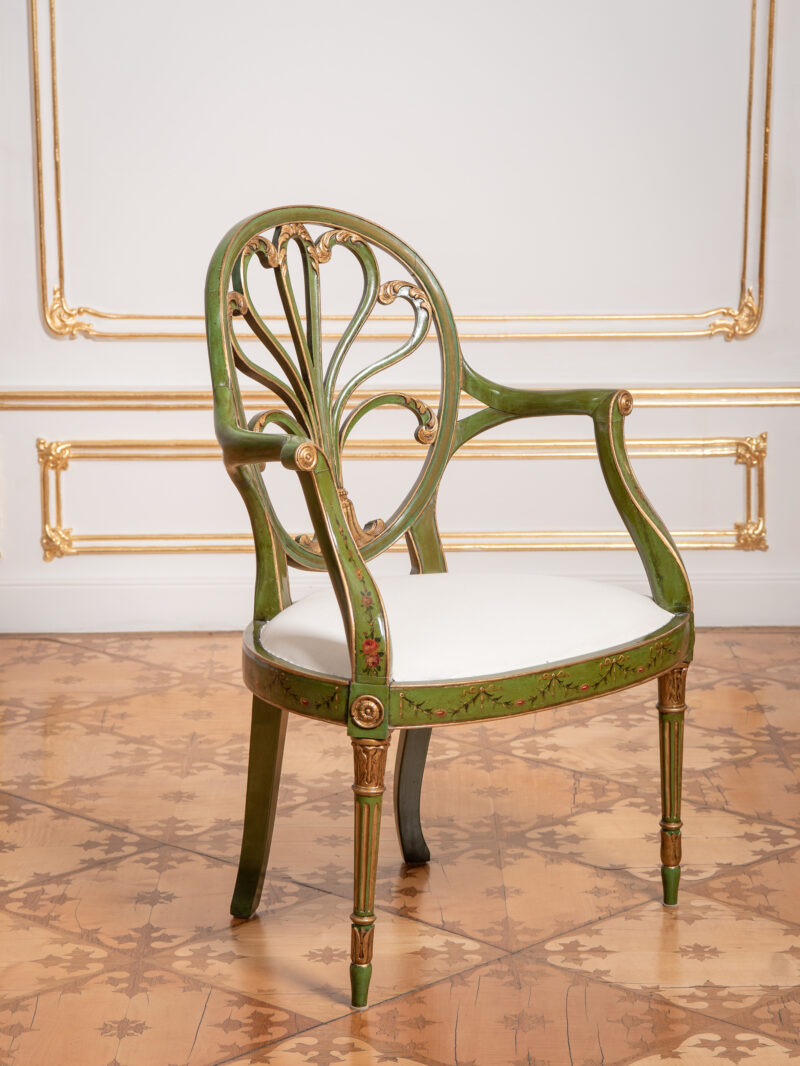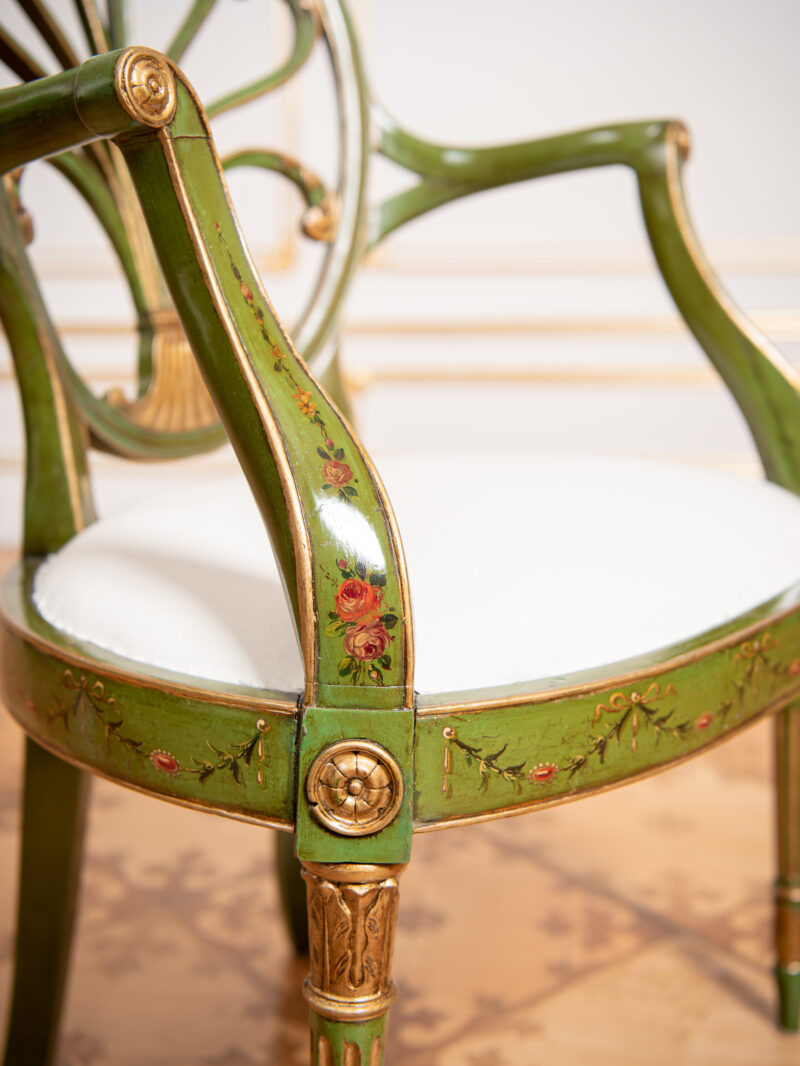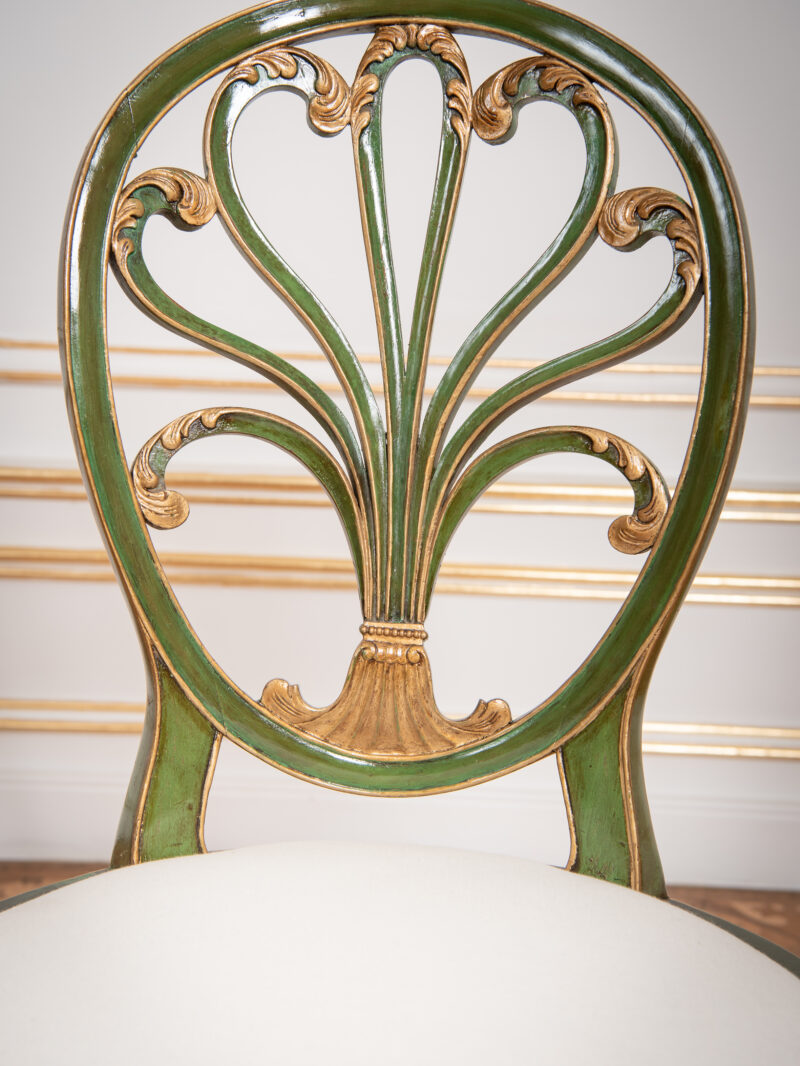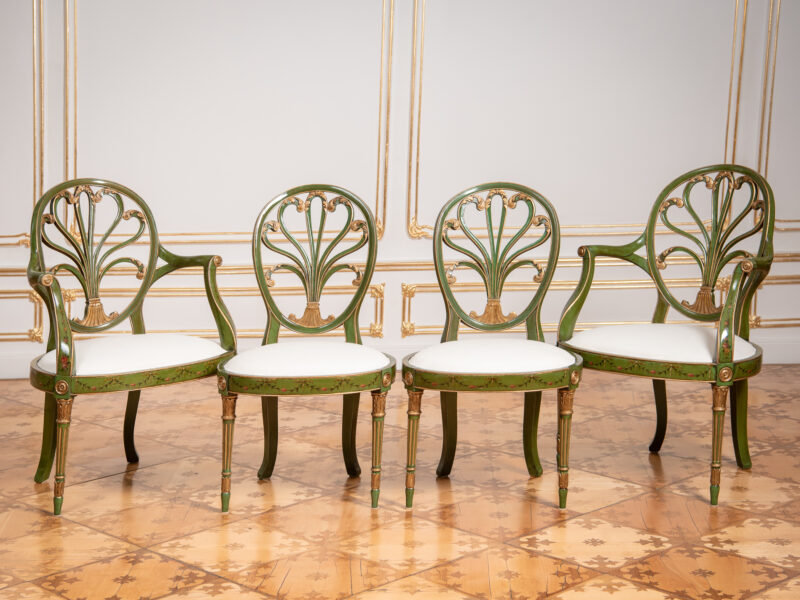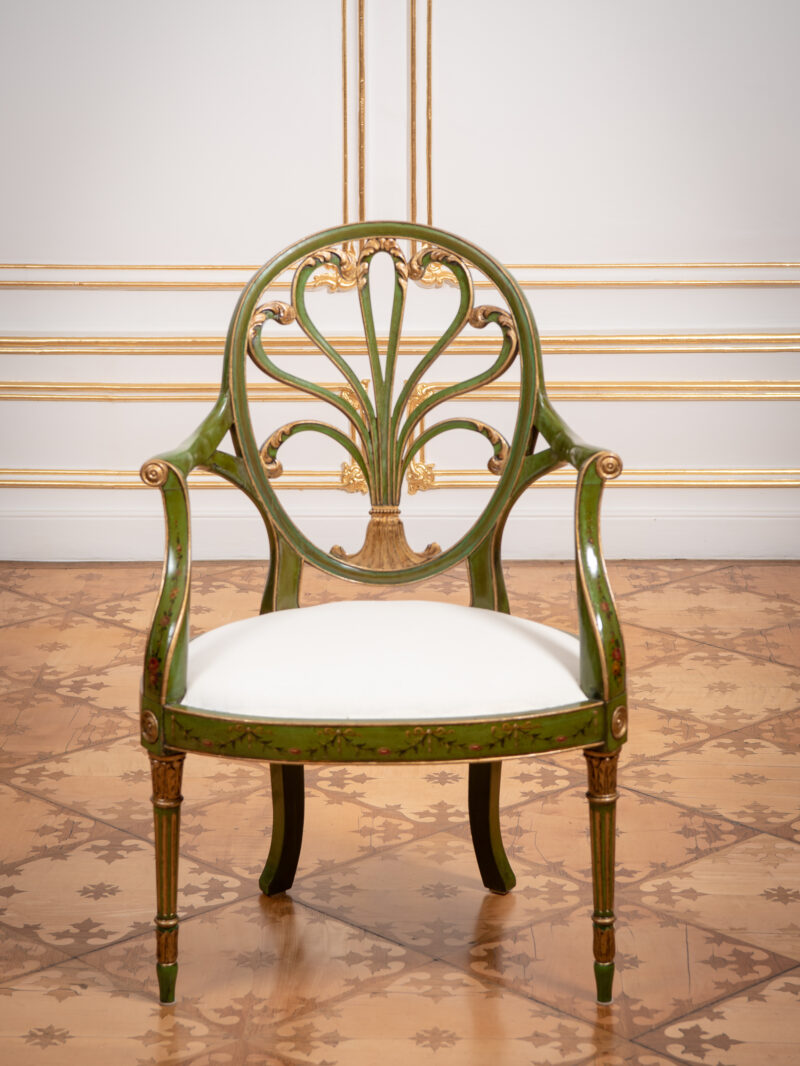
Set of Florally Decorated, Green Chairs, Vienna around 1900
Beautifully decorated chairs with an oval, anthemion-shaped (honeysuckle blossom) openwork and carved backrest. The set consists of two armchairs with slightly flared armrests and two side chairs. The chairs, painted in green with segmented gold accents, are adorned all around with very fine garlands of flowers, each featuring a centrally depicted ruby framed by pearls.
The front chair legs are partially fluted and decorated with leaf motifs. The restored chairs are currently upholstered with a white base fabric and will be covered with a decorative fabric of the client’s choice in our inhouse- workshop.
These are truly special, very rare chairs with exquisite green finishes and intricate floral and jewelry-style painting, making them perfect as seating for a small salon or sunroom.
On the Design:
The chair form, with pierced backrests in an anthemion (honeysuckle blossom) shape, corresponds to a design from March 1785, drawn by Gillow of Lancaster and depicted in the Estimate Sketch Books (see S. Stuart, Gillows of Lancaster and London 1730 – 1840, London, 2008, p. 175, as well as a similar design on p. 135). However, the basic form of the chairs existed even earlier, appearing between 1775 – 80 on the trade card of Vickers and Routledge, Conduit Street, London (published in A. Heal, The London Furniture Makers, London, 1953, p. 72, pl. 9). A suite of seating furniture in this style was also delivered around 1780 to Lyonel, 5th Earl of Dysart for Ham House, Surrey (see S. Thornton, “Ham House,” Furniture History, 1980, fig. 188). Another identical suite, consisting of open armchairs and matching window seats, was supplied by Gillow to George, 4th Earl and 1st Marquis of Cholmondeley (1749 – 1827) for Cholmondeley Castle, Cheshire, now at Houghton Hall. They are illustrated in S. Macquoid, The Age of Satinwood, London, 1908, figs. 102 and 115.
History – Gillows of Lancaster:
The firm of Gillows of Lancaster traces its origins to Robert Gillow (1704 – 1772), who established his workshop in 1730 after training as a cabinetmaker. In the 1730s, he began exploiting the lucrative West Indies trade by exporting mahogany furniture and importing rum and sugar. After his death in 1772, the business was continued by his two sons, Richard (1734 – 1811) and Robert (1745 – 1793). In 1764, Thomas Gillow and William Taylor established a London branch at 176 Oxford Road, today known as Oxford Street.
The firm quickly gained a reputation as a supplier of high-quality furniture to the wealthiest families in the country. Toward the end of the 19th century, Gillows faced financial difficulties and entered into a loose financial arrangement with Waring of Liverpool from 1897, which was legally formalized by the creation of Waring & Gillow in 1903.
Warings of Liverpool had been founded by John Waring, who had moved to the city from Belfast in 1835 and established a wholesale furniture business. His son, Samuel James Waring, expanded the business rapidly during the 1880s, furnishing hotels and public buildings across Europe. He also founded the Waring-White Building Company, which constructed the Liverpool Corn Exchange, Selfridge’s Department Store, and the Ritz Hotel.
Gillows also earned a reputation for furnishing luxury yachts and ships, including the royal yacht Victoria and Albert, as well as the Lusitania, Heliopolis, Cairo, and the RMS Queen Mary (1934) and Queen Elizabeth (1946) for Cunard. During World War I, the Lancaster factory was converted to war production, manufacturing ammunition boxes for the Navy and propellers for De Havilland DH9 aircraft. In World War II, the company produced parts for gliders and Mosquito aircraft, while the upholstery department made duffel bags, tents, and camouflage nets.
However, the firm’s business steadily declined, and the Lancaster workshops were closed on March 31, 1962. In 1980, Waring & Gillow merged with the furniture makers Maple & Co to form Maple, Waring & Gillow, which later became part of the Allied Maples Group Ltd., which also included Allied Carpets.
(From The National Archives, City of Westminster Archives Centre)
Friedrich Otto Schmidt, History:
In 1858, Carl Friedrich Heinrich Schmidt (June 29, 1824, Stralsund – October 22, 1894, Seewalchen), who came from a Saxon family of carpenters that had been established in the Prussian region since the 18th century, decided to move to Vienna.
Schmidt, who completed his commercial training in Hamburg and moved to Prague in 1850 to work at the wallpaper factory “Robert & Bhd. Sieburger” (where he managed the Budapest branch from 1853 to 1857), saw, like many artists and craftsmen, the imperial city of Vienna — with its rapid urban growth and the construction of the Ringstrasse — as a lucrative opportunity for professional self-realization.
After initially founding the wallpaper business “F. Schmidt & Sugg” in 1859 together with Gerhard Joseph Hubert Sugg (born November 27, 1832, Cologne) at Bischofgasse 637 (today Rotenturmstrasse 11) in Vienna’s 1st district, Schmidt took over full ownership of the company in 1872 and renamed it “Friedrich Otto Schmidt.“
The company experienced significant commercial success with the entry of his eldest son, Otto Erdmann Schmidt (October 4, 1854, Budapest – March 16, 1895, Vienna), and expanded into a “Technical Atelier for Interior Decorations,” offering complete interior designs including stucco decorations and fireplaces.
The firm became not only one of the most successful interior decorators in the second half of the 19th century but also actively participated in Arthur von Scala’s reform movement at Vienna’s Museum of Art and Industry, which aimed, following the English model, to improve the collaboration between art and craftsmanship and to break with the tradition of historicism.
Soon, Schmidt moved away from historicist imitations of older forms and focused instead on the exact replication of historical models, from individual pieces of furniture to complete interiors. Schmidt’s passion for contemporary movements was also reflected in his personal life. In 1874, his villa Daheim in Seewalchen, Upper Austria, designed by architect Zinner, was completed. There, he maintained friendships with artists, writers, and musicians such as Hans Makart and Friedrich von Amerling. When Carl Friedrich Heinrich Schmidt died in 1894 and his eldest son Otto passed away in 1895, his other son, Max Hermann Schmidt (August 11, 1861, Vienna – April 1, 1935, Budapest), took over the company.
Max Hermann had trained during the 1880s with the interior designer Prignot in Paris and the furnishing company Pallenberg in Cologne.
He joined the family business in 1889 and became sole owner in 1894. Together with his brothers Carl Leo (February 20, 1867, Vienna – May 15, 1942, Vienna) and Hugo Wilhelm (February 2, 1856, Budapest – February 16, 1932, Vienna), he restructured and expanded the “Technical Atelier for Interior Furnishings” by the turn of the century. In 1896, a second branch was opened at Waisenhausgasse 7 (today Boltzmanngasse) in Vienna’s 9th district, alongside the store at Rotenturmstrasse 11.
In 1897, a shop was opened at Lipót körút 32 (today Szent István körút) in Budapest. In 1898, the company moved from Rotenturmstrasse into the baroque Palais Neupauer-Breuner at Singerstrasse 16 in Vienna’s 1st district.
Private apartments and storage rooms were housed at Waisenhausgasse 7. In 1900 and 1910, further branches were opened at Bachergasse 5 in Vienna’s 5th district and at Eisengasse 5 (today Wilhelm-Exner-Gasse) in Vienna’s 9th district, though these were eventually closed over the years.
A particularly productive collaboration developed with the architect Adolf Loos, who worked closely with Max Hermann Schmidt and, for example, inspired the well-known “Elephant Trunk Table” (1899), which from 1900 onward appeared in various versions in numerous interior projects.
In addition to working with Loos, the company also collaborated with the Vienna Secession. Following plans by Josef Hoffmann, they furnished the entrance hall and secretary’s office in the Secession exhibition building.
Since 1907, the Palais Chotek at Währingerstrasse 28 in Vienna’s 9th district has served as the company headquarters. The historic Renaissance-style building was first rented as an atelier in collaboration with architect Lothar Abel (February 15, 1841, Vienna – June 24, 1896, Vienna) and finally purchased in 1904. After Carl Leo’s death in 1942, his son Erich Schmidt (February 27, 1910, Vienna – June 14, 1980, Vienna) and his wife Irene, née Eder (July 13, 1910, Vienna – June 21, 2001, Vienna), took over the business.
From 1968, their daughter Irene (born August 31, 1948, Vienna) served as managing director, while her husband Klaus Lorenz (May 23, 1943, Scheibbs – December 24, 2016, Vienna) was appointed as authorized signatory.
Today, the company is run by Irene and her two children, Irene (born February 15, 1967, Vienna) and Claus Lorenz (born March 15, 1966, Vienna).
Claus Lorenz is also responsible for overseeing the Friedrich Otto Schmidt archives.
Literature:
“Wagner, Hoffmann, Loos und das Möbeldesign der Wiener Moderne” (pp. 147 ff.) Artists, Patrons, Producers, Vol. 37, edited by Eva B. Ottillinger, Dr. Stefan Üner, M MD
